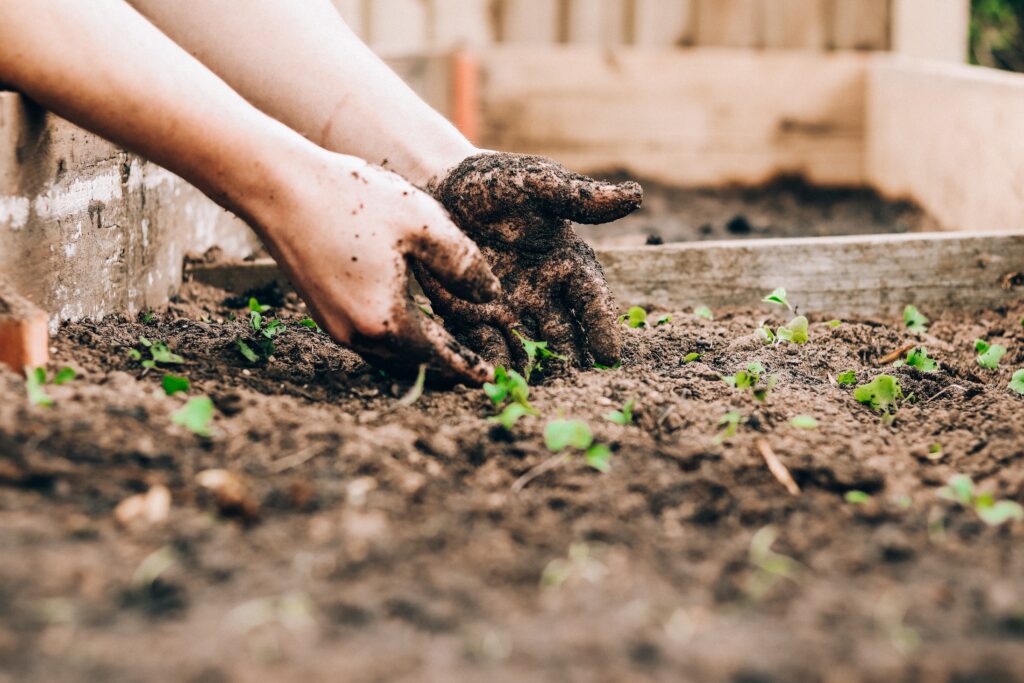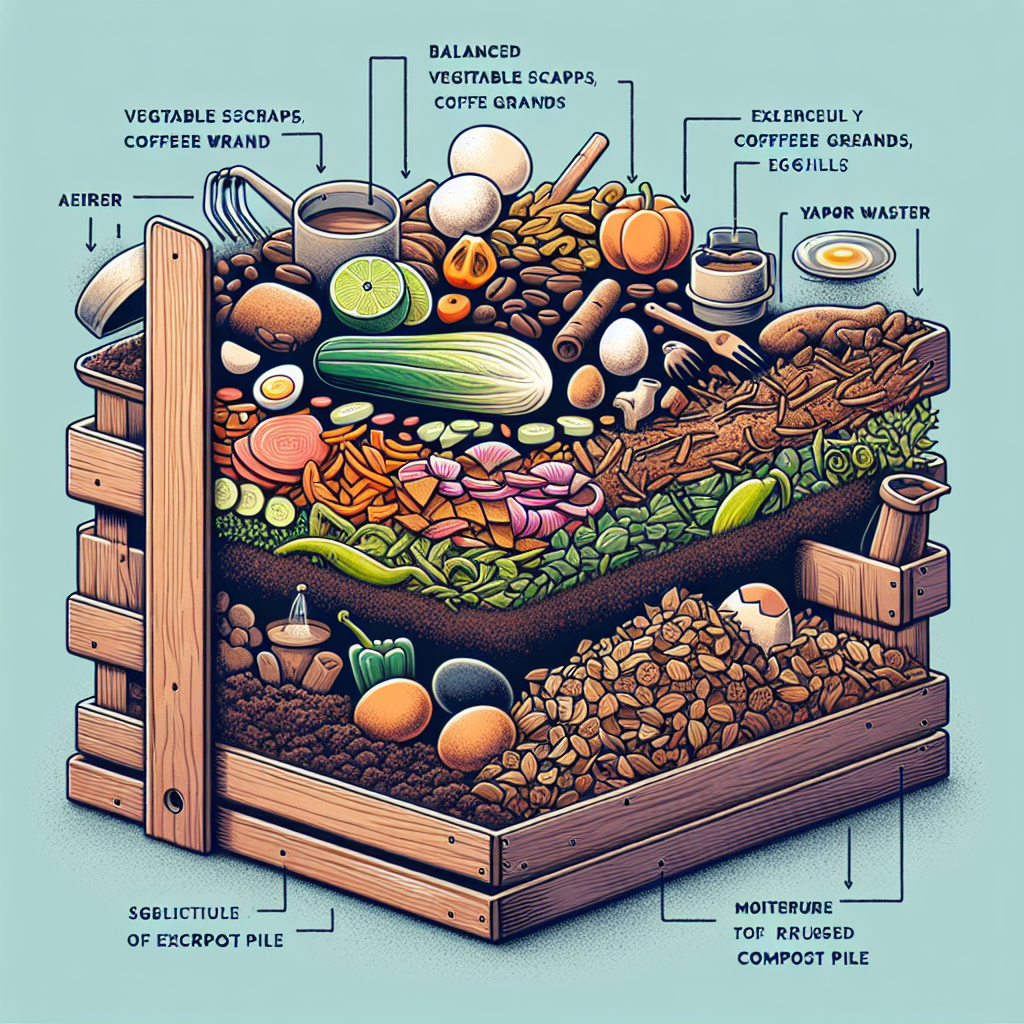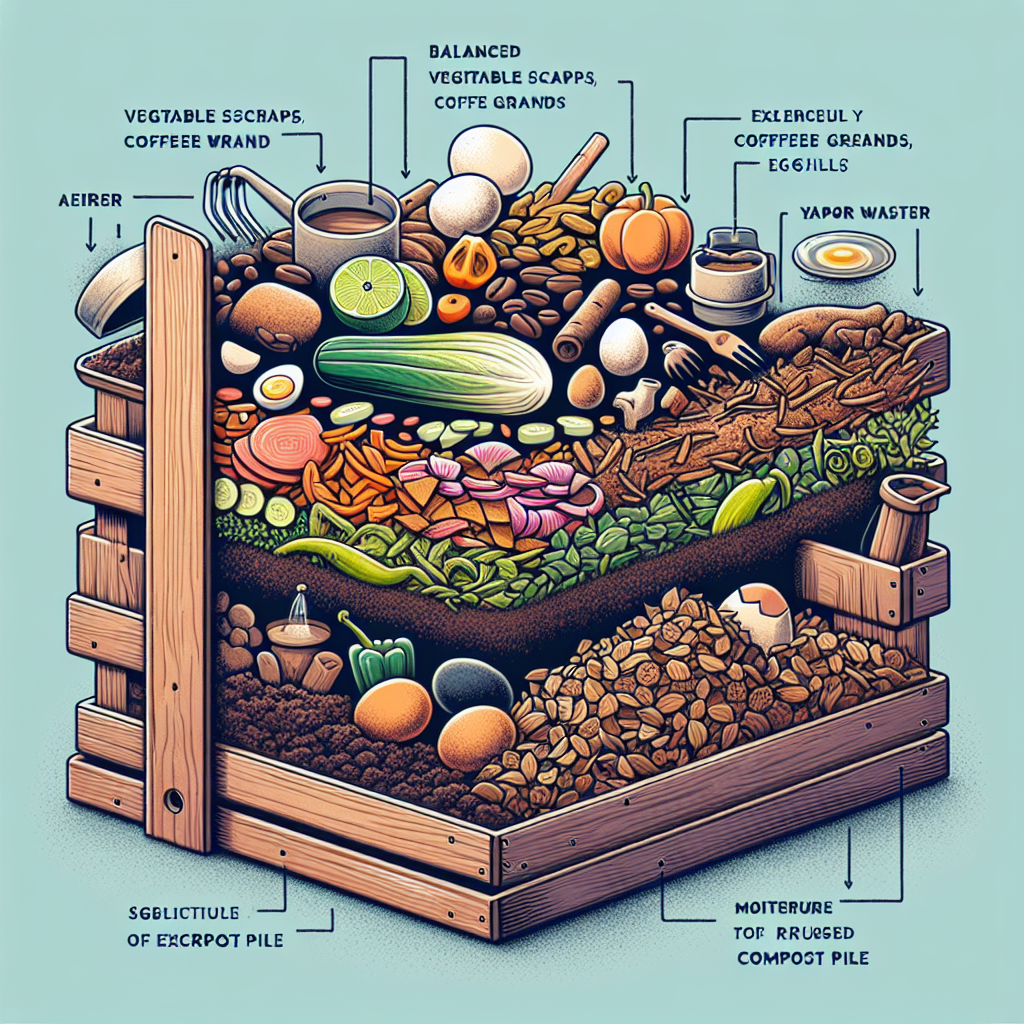If you’re looking to create a thriving compost pile, there are four essential ingredients you need to have. These ingredients are the secret to turning your kitchen and yard waste into nutrient-rich soil for your plants and garden. Without further ado, let’s uncover the key components that will guarantee the success of your composting journey.
Check Out Our Recommended Composting Products on Amazon Right Here!
Exploring the World of Compost Pile
Choosing the Right Ingredients
When it comes to creating a successful compost pile, selecting the right ingredients is crucial. Compost piles require a balance of organic materials that provide a healthy environment for decomposition. There are two main types of organic materials that should be included in your compost pile: carbon-rich materials and nitrogen-rich materials.
Carbon-rich Materials
Carbon-rich materials are often referred to as “browns” and include items such as dried leaves, straw, paper, and wood chips. These materials provide a source of energy for the microorganisms and bacteria responsible for breaking down the organic matter. Carbon-rich materials also help create airflow within the pile, ensuring that oxygen reaches all parts of the compost.
Nitrogen-rich Materials
Nitrogen-rich materials, also known as “greens,” consist of items such as grass clippings, vegetable scraps, and coffee grounds. These materials provide essential nutrients for the microorganisms and bacteria in the compost pile. Nitrogen-rich materials also help maintain the temperature of the compost pile, allowing for faster decomposition.
Avoiding Certain Materials
While many organic materials can be used in a compost pile, some items should be avoided. These include meat, dairy products, and oils, as they can attract pests and rodents. Additionally, materials treated with chemicals, such as pesticides or herbicides, should not be included in the compost pile, as these can harm the beneficial microorganisms and bacteria.
Maintaining the Right Balance
Achieving the right balance of carbon-rich and nitrogen-rich materials is crucial for a successful compost pile. The ratio of carbon to nitrogen, also known as the C:N ratio, should be approximately 30:1. This balance ensures that the compost pile has enough energy (carbon) and nutrients (nitrogen) for decomposition to occur efficiently.
Monitoring Moisture Levels
Moisture is another important factor to consider when maintaining a compost pile. The ideal moisture level for compost is around 50-60%. This moisture content provides enough water for the microorganisms and bacteria to thrive without creating an overly wet environment that can lead to anaerobic conditions.
To monitor moisture levels, you can use a moisture meter or simply squeeze a handful of compost. If it feels too dry, add water gradually. On the other hand, if it feels too wet, add dry carbon-rich materials to absorb the excess moisture.
Turning the Pile
Turning the compost pile is essential for maintaining airflow and promoting even decomposition. When you turn the pile, you introduce oxygen, which is necessary for the aerobic breakdown of organic matter. Turning the compost also helps mix the ingredients and distribute moisture evenly throughout the pile.
It is recommended to turn the compost pile every 1-2 weeks, using a pitchfork or compost turning tool. This allows the outer materials to move towards the center, where decomposition is most active, while exposing the inner layers to oxygen.

Check Out Our Recommended Composting Products on Amazon Right Here!
Providing Adequate Airflow
Proper airflow is crucial for a healthy compost pile. Oxygen is needed for the decomposition process to proceed aerobically, preventing the production of foul odors. Without adequate airflow, the compost pile can become compacted, leading to anaerobic conditions and the release of unpleasant smells.
Importance of Oxygen
Oxygen plays a vital role in the composting process. It supports the growth of beneficial aerobic microorganisms and bacteria that break down the organic matter. These organisms require oxygen to convert the carbon-rich and nitrogen-rich materials into nutrient-rich compost.
By ensuring proper airflow within your compost pile, you create an oxygen-rich environment that encourages the growth of these beneficial organisms.
Layering the Ingredients
Layering the ingredients in your compost pile promotes optimal airflow and decomposition. Start by creating a base layer of carbon-rich materials, such as dried leaves or wood chips. Add a layer of nitrogen-rich materials, like grass clippings or vegetable scraps, on top of the carbon layer. Continue alternating between carbon-rich and nitrogen-rich layers until you have used all of your compost materials.
Layering the ingredients helps create air pockets within the compost pile, allowing oxygen to reach all parts of the pile. It also helps maintain the desired carbon-to-nitrogen ratio, ensuring a balanced environment for decomposition.
Using Aerator Tools
If you’re facing challenges with maintaining airflow in your compost pile, consider using aerator tools. These tools are specifically designed to pierce through the pile, creating channels for oxygen to reach the center. They can be particularly useful when dealing with compacted or densely packed compost materials.
Aerator tools come in various forms, such as handheld or long-handled devices with rotating tines or spikes. Using these tools periodically can help improve airflow and maximize the composting process.
Controlling Temperature and pH
Temperature and pH are important factors to consider in maintaining a healthy compost pile. Both temperature and pH can affect the activity of microorganisms and bacteria, ultimately influencing the speed and efficiency of decomposition.
Optimal Temperature Range
The ideal temperature range for a compost pile is between 110-160°F (43-71°C). Within this range, the decomposition process is most active, and harmful pathogens and weed seeds are effectively destroyed. Temperature fluctuations are normal during the composting process, but it is essential to monitor and maintain the temperature within this optimal range.
Monitoring pH Levels
pH is a measure of the acidity or alkalinity of a substance. In composting, pH levels affect the activity of microorganisms and bacteria. The optimal pH range for a compost pile is typically between 6 and 8. Maintaining the correct pH level ensures the conditions are favorable for the decomposition process.
You can monitor the pH of your compost pile using a pH testing kit or strips specifically designed for compost. Adjusting the pH can be done by adding materials with the desired acidity or alkalinity. For example, adding lime can raise the pH, while adding sulfur can lower it.
Adjusting Temperature and pH
If the temperature of your compost pile falls outside the optimal range, there are steps you can take to adjust it. Adding carbon-rich materials, such as dry leaves or wood chips, can help increase the temperature, as these materials provide the energy needed for decomposition.
To adjust the pH of your compost pile, you can add materials that are acidic (such as coffee grounds or pine needles) or alkaline (such as crushed eggshells or wood ashes). Gradually introduce these materials to achieve the desired pH level, ensuring that you monitor the pH throughout the process.

Understanding the Decomposition Process
Composting relies on the natural process of decomposition, which involves various microorganisms, bacteria, enzymes, and fungi working together to break down organic materials.
Microorganisms and Bacteria
Microorganisms and bacteria are the primary decomposers in a compost pile. These tiny organisms feed on the organic matter, breaking it down into simpler compounds. The nutrients released by the decomposition process are then available for plants to use.
To support the growth of microorganisms and bacteria, it is crucial to provide the right conditions in your compost pile, such as proper moisture, temperature, and airflow.
Enzymes and Fungi
Enzymes also play a significant role in the decomposition process. These biological catalysts speed up chemical reactions, breaking down complex organic molecules into smaller, more manageable compounds. Enzymes work in conjunction with microorganisms and bacteria to efficiently decompose the organic matter in your compost pile.
Fungi, such as mushrooms or mold, also participate in decomposition. They help break down tougher materials, such as wood or plant fibers, and contribute to nutrient cycling.
Heat and Carbon Dioxide Release
As decomposition occurs, heat is generated within the compost pile. This heat is a byproduct of the metabolic processes of microorganisms and bacteria breaking down organic matter. The temperature increase is particularly noticeable during the active decomposition phase.
Additionally, the decomposition process produces carbon dioxide (CO2) as a byproduct. While most of the carbon is converted into stable organic compounds, some is released as CO2. This is a natural part of the composting process and contributes to the breakdown of organic matter.
Factors Affecting the Composting Process
Several factors can influence the composting process, affecting the speed and success of decomposition. Understanding these factors can help you troubleshoot any issues that may arise.
Temperature
Temperature is one of the most critical factors in composting. As mentioned earlier, maintaining the ideal temperature range promotes the growth of beneficial microorganisms and bacteria, ensuring efficient decomposition. Fluctuations in temperature can slow down or stall the composting process.
Moisture
Moisture is essential for the composting process, as it provides the necessary environment for microorganisms and bacteria to thrive. Too much moisture can lead to anaerobic conditions or a foul odor, while too little can slow down decomposition. Monitoring and adjusting moisture levels as needed will help maintain the ideal conditions for composting.
Airflow
Adequate airflow is crucial for aerobic decomposition. Without enough oxygen, the compost pile can become compacted and anaerobic, resulting in unpleasant smells and slower decomposition. Properly layering the ingredients and turning the pile regularly help maintain airflow throughout the compost pile.
Compost Size
The size of your compost pile can impact decomposition. A larger pile generates more internal heat, creating an ideal environment for decomposition. However, larger piles may require more effort to turn and monitor. Smaller piles may decompose more slowly due to a lack of mass to generate sufficient heat.
Compost Activators
Compost activators, such as finished compost, manure, or commercial compost accelerators, can help speed up the decomposition process. These activators contain a high concentration of beneficial microorganisms and bacteria that jumpstart decomposition. Using them in your compost pile can increase the rate of breakdown and produce compost more quickly.

Troubleshooting Common Issues
While composting is a relatively straightforward process, certain issues may arise along the way. Here are some common problems and their solutions:
Foul Odor
Foul odors in your compost pile may indicate anaerobic conditions caused by insufficient airflow or excessive moisture. To remedy this, turn the pile to introduce more oxygen and adjust the moisture levels. Adding dry carbon-rich materials, like wood chips or shredded paper, can help absorb excess moisture and prevent unpleasant smells.
Slow Composting
If your compost pile is decomposing more slowly than expected, it may be due to inadequate moisture, incorrect carbon-to-nitrogen ratio, or a lack of oxygen. Adjusting these factors, such as adding water or balancing the ingredients, can help speed up the composting process. Regularly turning the pile also ensures even decomposition and faster results.
Pests and Rodents
Pests and rodents can be attracted to a compost pile that contains meat, dairy products, or oils. It is essential to avoid these items in your compost to prevent unwanted visitors. If pests become an issue, consider using a covered compost bin or adding a layer of wire mesh to deter them from accessing the pile.
Excessive Moisture
Excessive moisture can lead to anaerobic conditions and a foul odor in your compost pile. To address this, add dry carbon-rich materials, like dried leaves or wood chips, to absorb the excess moisture. Turning the pile will also help aerate the compost and promote evaporation.
Tips for Managing a Successful Compost Pile
To ensure your compost pile thrives and produces nutrient-rich compost, consider incorporating these tips into your composting routine:
Chop Large Materials
Chopping large materials into smaller pieces before adding them to the compost pile can help speed up decomposition. Smaller pieces have a larger surface area, allowing microorganisms and bacteria to break them down more efficiently.
Regularly Monitor and Turn the Pile
Regular monitoring and turning of the compost pile are essential for maintaining the right conditions. Check the moisture levels, temperature, and odor regularly to identify any adjustments needed. Turning the pile every 1-2 weeks ensures even decomposition and promotes airflow.
Add Moisture or Dry Materials as Needed
As mentioned, maintaining the correct moisture level is crucial for a successful compost pile. Add water gradually if the compost is too dry, and mix in dry carbon-rich materials if the pile is overly wet. Regularly monitoring and adjusting the moisture content will help create an optimal environment for decomposition.

Using Compost in Your Garden
Once your compost has fully decomposed and transformed into dark, crumbly, and earthy-smelling material, it is ready to be used in your garden. However, a few additional steps should be taken before incorporating it into the soil.
Curing the Compost
Curing, or aging, the compost for a few weeks before using it in your garden allows the remaining organic matter to break down further and ensures that any harmful pathogens or weed seeds have been eliminated. Simply transfer the finished compost to a separate bin or pile and let it sit for a few weeks.
Incorporating the Compost into Soil
To take full advantage of the nutrients in the compost, it should be incorporated into the soil. Digging or tilling the compost into the garden beds allows the nutrients to be evenly distributed throughout the soil, improving its structure and fertility.
Topdressing and Mulching
You can also use compost as a topdressing by spreading a thin layer over the soil surface. This helps retain moisture, suppresses weeds, and provides a slow-release source of nutrients. Additionally, compost can be used as mulch around plants and trees to conserve soil moisture and regulate temperature.
Conclusion
Creating a successful compost pile requires careful consideration of the ingredients, maintaining the right balance, providing adequate airflow, and controlling temperature and pH levels. Understanding the decomposition process and factors that can affect it will help troubleshoot any issues that may arise. By following these tips and utilizing the nutrient-rich compost in your garden, you can contribute to a healthier and more sustainable environment. Happy composting!
Check Out Our Recommended Composting Products on Amazon Right Here!




